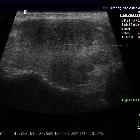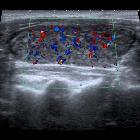De Quervain thyroiditis







De Quervain thyroiditis, or subacute granulomatous thyroiditis, is a form of self-limited subacute thyroiditis usually preceded by an upper respiratory tract viral infection such as mumps, measles, coxsackie virus, adenovirus, and influenza viruses.
Epidemiology
It usually affects middle-age females.
Clinical presentation
Most patients present with a painful neck along with symptoms and signs of thyrotoxicosis including tachycardia, hot flushes, heat intolerance and palpitations. Subsequently, a short period of hypothyroidism ensues, followed, in the majority of cases, by a return of a euthyroid state.
Radiographic features
Ultrasound
The most commonly described sonographic appearance is poorly defined regions of decreased echogenicity with decreased vascularity in the affected areas . These can be bilateral or unilateral. The thyroid gland size is mostly normal but can occasionally be enlarged or smaller in size .
Nuclear medicine
Low uptake thyroid scan in patients with hyperthyroidism is almost diagnostic, in appropriate clinical setting and ultrasound findings. Correct diagnosis is important as treatment with radioiodine is contraindicated in these patients - it is a self-limiting disease.
Treatment and prognosis
It is usually self-limiting.
History and etymology
Named after Fritz de Quervain (1868-1940), a Swiss surgeon.
See also
Siehe auch:
und weiter:

 Assoziationen und Differentialdiagnosen zu Subacute granulomatous thyroiditis:
Assoziationen und Differentialdiagnosen zu Subacute granulomatous thyroiditis:
